Before planting potatoes, the tubers are germinated. This technique is of paramount importance in obtaining earlier production.
|
Sprouting potatoes before planting allows you to get earlier production, increase productivity and even protect the tubers from pests. |
| Content:
|
Why do you need to sprout potatoes?
Potato germination is often called vernalization. In principle, this is almost the same thing, but vernalization is a broader concept, which also includes pre-planting treatment of seed material with pesticides, heating and germination.
Germination is aimed only at obtaining tubers with strong, short, thick sprouts and root rudiments.
What benefits do we get by germinating potatoes before planting:
- reduction of the growing season by 10-14 days;
- increase in yield by 15-20%;
- the ability to plant sprouted potatoes in colder soil without compromising seedlings and harvest;
- shoots appear 10-12 days earlier, spring cooling does not inhibit potato germination so much;
- early varieties produce a harvest before late blight appears;
- natural protection against rodents, since when exposed to light, corned beef is formed in the tubers, which is poisonous to mice and rats.
Planting with chilled tubers that have just been taken out of the cellar is unacceptable. It leads to massive thinning of seedlings and significantly lengthens the growing season.
Harvest dates in this case shift by 1-1.5 months. For late varieties this is especially dangerous, since in the event of an early onset of cold weather it may not yet be ready.
Methods of vernalization
There are several methods of vernalization:
- In the light. The potatoes are laid out in a bright room; direct sunlight is allowed for several hours a day.
- Wet. The potatoes are placed in a humid environment.
- Combined. First, potatoes are germinated in the light and then placed in a moist substrate.
- Warming up. Used for difficult-to-germinate seed material.
The most common method is vernalization in the light
Germination time
Unsprouted tubers in the ground begin to germinate 10-12 days after planting, and in cold spring after 25-30 days. The first shoots appear after 17-20 days or after 32-37 days, respectively.
|
If you grow seed potatoes before planting, seedlings will appear much earlier |
To speed up the emergence of seedlings and further development of plants, seed tubers are germinated. They begin to sprout potatoes 1-1.5 months before planting.
If this is done earlier, then by the time of planting the sprouts will be too elongated, weak and thin. Such tubers do not sprout for a long time. When vernalized less than 2-3 weeks before planting, the tubers will not produce strong shoots; during this time their eyes will only just awaken. You cannot plant such potatoes, as they will take a very long time to germinate.
Germination in the light
Any bright and sufficiently warm room, where during the day the temperature is at least 18°C and at night at least 12°C, is suitable for vernalization. At a temperature of 5-7°C, germination slows down greatly, and at 20°C and above, the potatoes dry out greatly and the sprouts become woody. Such plants usually fall out, and when germinating they are weak and produce small tubers.
Light is necessary for the formation of short, thick, dark green or purple sprouts that do not break off when transporting, carrying, tedding and planting potatoes. In the light, the tubers turn green, become unsuitable for food, and corned beef accumulates in them, which is poisonous to animals and humans.
|
Most of the corned beef is in the sprouts themselves. It protects seeds from damage by rodents. |
To obtain early production, potatoes are sprouted for 45 days before planting, making sure that the sprouts are not more than 4 cm.If the sprouts are already large and the planting date has not yet arrived, the potatoes are put in a cool place with a temperature of 4-7°C.
In other cases, germination lasts 30-35 days. Tubers ready for planting should have thick purple or greenish sprouts 0.5-2 cm long. Such sprouts do not break off when planted.
In an insufficiently lighted room, thin, white, weak, long shoots are formed. They break off easily and are of no use. Potatoes with such sprouts take as long to germinate as unsprouted ones.
Germination indoors
For germination, seed material is taken out of the cellar 2 months before planting, carefully sorted and placed in a bright, warm room in 2-3 layers, and if possible, in one layer.
Lay out the seed material on the floor, window sills or on the table, but without direct sunlight. At least once a week, the potatoes are sorted, turning the bottom side up so that the entire tuber receives a sufficient amount of light. Diseased tubers are immediately removed. During vernalization in a humid room, the seed material is pollinated with ash.
|
If there are a lot of seed potatoes, then they are laid out in shallow boxes, which are placed on top of each other so that there are gaps between them. Every 10 days, the top and bottom drawers are swapped. |
If there is not enough space, potatoes are sprouted in light plastic bags. Holes up to 1 cm in diameter are evenly made along the entire length of the bag to allow oxygen to enter and carbon dioxide released during germination to be removed. The bag is filled 2/3 full, tied tightly and hung in a bright place without direct sunlight.
If the bags are too large, then the potatoes are evenly distributed at both ends, and the bag is hung in the middle on a crossbar. Under these conditions, all tubers are evenly illuminated.
|
Once every 10 days, the bag is turned so that the less illuminated side is exposed to the light. |
If there is no space at all, then seed potatoes are strung on wire or fishing line and hung in the shade in a warm place. With uniform lighting, strong shoots are formed. But this method is good if there is not too much seed material.
During vernalization, you need to monitor humidity. When exposed to light and heat, potatoes quickly begin to evaporate moisture and shrink. Typically, in apartments and houses where vernalization occurs, the humidity is low and the tubers, although they have sprouts, dry out almost completely by the time of planting.
After planting, they have nowhere to get nutrients for growth. Such tubers fall out and the plantings become thinned out. To maintain optimal humidity, seed material is sprayed every 7-10 days. At high temperatures, place a bowl of water in the room and hang a wet rag on the radiator.
|
The optimal humidity for germination is 80-85%. In residential premises it is maintained at 75%. At low humidity, the top largest sprouts of potatoes die off. |
If the seed material has sprouted during storage, then all the thin long sprouts are broken off. Each eye has several growth buds, so instead of a removed sprout, the next bud emerges from the same eye with an interval of 7-10 days.
2 weeks before planting, all overgrown, as well as long and thin sprouts are broken off. However, it is worth remembering that in many late varieties and in some medium ones (Nevsky, for example), the second sprout from the same eye appears after 25-30 days.Therefore, on such varieties it is impossible to break off overgrown sprouts shortly before planting.
Germination of exhausted and substandard potatoes
When germinating substandard small potatoes, as well as potatoes that have sprouted and become very depleted in the cellar, they are sprayed with fertilizer solutions during vernalization. This is troublesome, but allows you to get good quality tubers.
Thin white sprouts are broken off from potatoes sprouted in the cellar and after 3-4 days they are sprayed with a solution of complex fertilizer (Malyshok, Mortar, nitroammofoska). For 3 liters of water 1 tsp. fertilizers
|
The treatment is carried out in the morning, without leaving excess solution under the planting tubers. |
After 10 days, the potatoes are sprayed with boric acid. Boron, although a trace element, has an extremely important effect on plant development. For 3 liters of water take 0.5 tsp. boric acid. Spray thoroughly, trying to get into the eyes with the sprouts. Treatment with boric acid is carried out once.
After 10 days, the potatoes are again sprayed with mineral fertilizers. The processing is not carried out too intensively. The seed must dry completely within 2 hours.
Vernalization outdoors
It is used when there is no room for indoor vernalization of seed material. Often on spring days it is warmer outside than in a still unheated country house. To speed up the formation of sprouts, potatoes are placed directly on the plot in sunny places.
When the temperature at night is above 3°C and rises to 10°C during the day, choose a flat area near the house on the south side. Straw, hay, sawdust, peat, rags or mats are laid on the ground in a layer of 10-12 cm. Potatoes are laid out on the litter in strips of a maximum of 2 layers.
Strip width 1.5 m.A passage a meter wide is left between them, where hay, straw or spunbond is placed to cover the seeds. Seed material is covered at night and on sunny days at noon.
|
Vernalization in the open air takes 18-24 days. |
Under the influence of heat and sun, potatoes begin to germinate very quickly. More sprouts appear on each tuber than with vernalization at home. All shoots are short, thick, woody and very strong. Even if they are overgrown, they do not break off when planted.
Potatoes sprouted in the sun have woody sprouts and are not prepared to grow immediately after planting. A substance accumulates in them, preventing their further development, and potatoes begin to sprout only after the destruction of these substances. In this regard, 7-10 days before planting, the sprouted tubers are covered with dark material or placed in a dark, cool room (temperature 7-12°C). In the dark, the substances that inhibit growth are destroyed, the sprouts become softer and more elastic, and the potatoes are ready for planting.
The entire period of vernalization in the open air also takes 30-35 days.
Germinating potatoes in the light is the most common and accessible method of vernalization.
Germination in a humid environment
The method allows you to get the harvest 7-10 days earlier.
Advantages:
- both sprouts and roots appear on the tubers;
- shoots appear faster;
- tuberization occurs earlier.
The main disadvantage is high labor intensity.
|
Summer residents rarely use this method. More often used in villages. |
The main conditions are fresh air circulation, heat (at least 12°C) and material humidity of 70-80%.
The substrate is peat, humus, sawdust. Potatoes are sprouted in small piles.A 1.5-2 cm layer of substrate is poured onto the bottom and seed potatoes are placed on it. Next, the layers alternate. It turns out 3-4 layers of seeds sprinkled with substrate. The top layer of tubers is covered with 2 cm of substrate.
When laying out the layers, the substrate is moistened. It must be kept moist throughout the entire germination period, otherwise the roots will grow very poorly. It is watered once every 5 days.
When using peat as a substrate, do not over-moisten it.
Peat absorbs a large volume of water, but when waterlogged, it spreads out. After drying, it forms a dense crust, depriving the lower tubers of air access, which is why they begin to rot. Therefore, it is better to make the top layer from sawdust. They should always be kept moist during the germination process. Moisten with a fertilizer solution: 1 tbsp per bucket. superphosphate and 1 tbsp. potassium sulfate.
|
The germination period in the substrate is 15-20 days, after which the seed material is immediately planted. |
If there are no roots on the tubers, but there are sprouts, they are planted. In the absence of sprouts, vernalization is carried out in the light.
Combined method
It is used for germinating substandard material that is difficult to germinate or for obtaining very early products. Rarely used.
The essence of the method: first get sprouts on the tubers, and then roots. Germination occurs within 40-50 days, but the harvest is obtained 15-20 days earlier.
Vernalization begins 2 months before planting. First, potatoes are germinated in light for 30 days. When thick and strong shoots appear, the seed material is placed in piles and covered with peat. When laying out in layers, each layer of peat is pre-moistened with a fertilizer solution. The top layer is covered with sawdust. Germinate for 10-15 days, not allowing the substrate to dry out.
Pre-sprouted potatoes take root very quickly. When they reach 10-15 cm, the tubers are taken out of the pile and immediately planted.
Warming up
It is used when potatoes take a long time to germinate or you need to speed up the process.
Seed tubers are filled with water at a temperature of 40-45°C for 20-30 minutes. Potassium permanganate is added to the water for disinfection. When the water has cooled, the tubers are air dried and placed near the radiator. The room temperature should be at least 20-22°C. If germination is slow, the potatoes are soaked again.
|
When germination is slow, to speed up the process, potatoes are heated in a room with a temperature of 30-35°C for 3-5 days. |
Sprouts appear after 15-20 days. The seed material turns green and produces strong, thick shoots.
Other methods
They are used for poor potato germination and the appearance of weak sprouts.
Contrast
The tubers are placed in a warm, bright place without direct sunlight for 2 weeks. The temperature should not be lower than 22°C. Then, regardless of whether sprouts have appeared or not, it is put away in a dark place with a temperature no higher than 10-12°C. Such a sharp change in temperature and light stimulates germination. After 4-5 days, it is again taken out into a bright and warm room.
Incision
Applies only to tubers that produce weak sprouts or do not sprout at all.
In the middle of the potato, a cut is made in a circle 5-7 mm wide and up to 1 cm deep. The potato becomes like the number 8. Then the seed material is laid out in a bright place, possibly in the sun. The technique stimulates germination and is carried out with single tubers, which really need to be preserved.
|
If the tubers were subsequently germinated in the sun, then before planting they are placed in the dark for 5 days to destroy substances that prevent germination. |
Germination of large tubers
Large tubers are cut into several parts. It is advisable that each part has 2-3 eyes. If there is a shortage of seed material, potatoes can be cut one eye at a time. It is cut along the tuber into pieces of 3-5 cm.
|
You cannot plant freshly cut tubers; they will rot in the ground. |
You can cut seed potatoes both in autumn and spring. When cut in autumn, a strong thick peel is formed on the cut, slightly different in color from the real one. When cutting in the spring, a plug is formed. It is preferable to carry out cutting a month before planting.
If you leave a small piece of pulp near the eye, it will not have enough nutrition. It may germinate during vernalization, but it will not be able to ascend.
Sliced potatoes are sprouted in the light without access to direct sun, spraying them once every 5 days.
Conclusion
It is most effective to germinate potatoes in the light by any method. All other methods are used when it is impossible to use the light method, there is a lack of space or for substandard material. They are all good in their own way, but very labor-intensive.
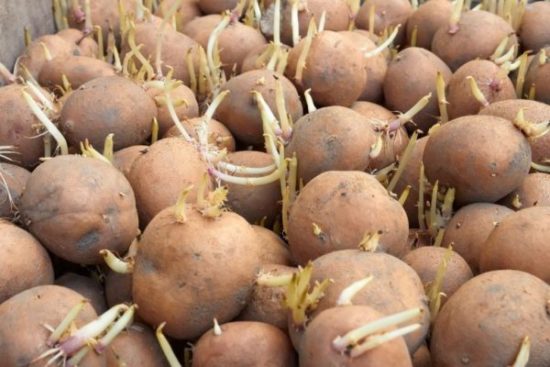
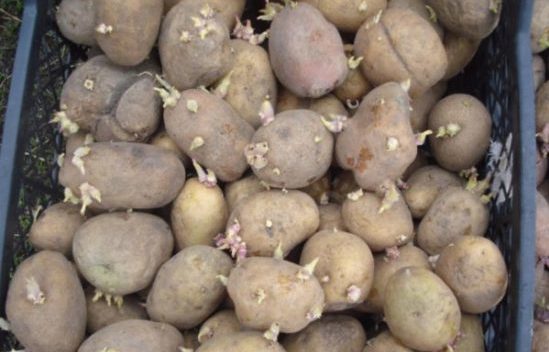
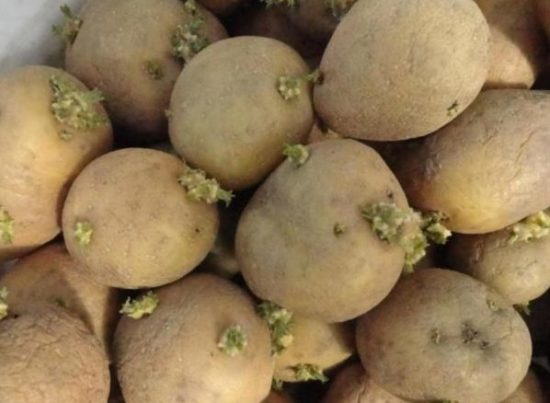
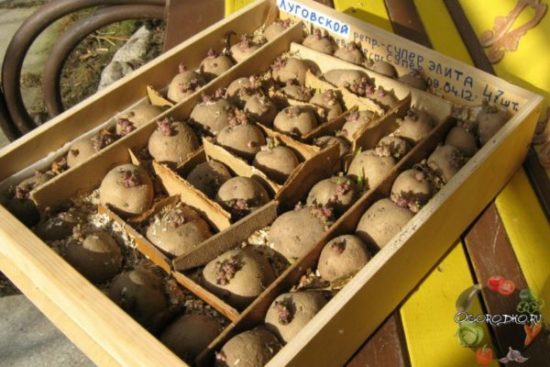
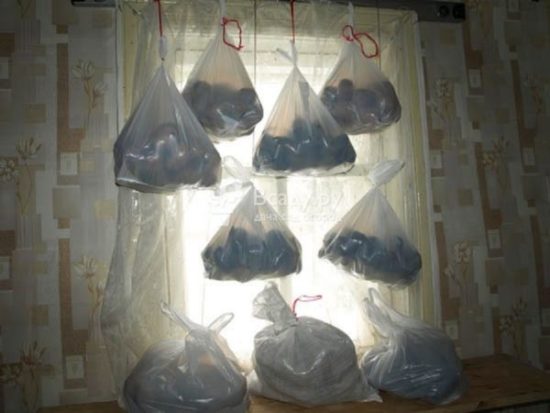
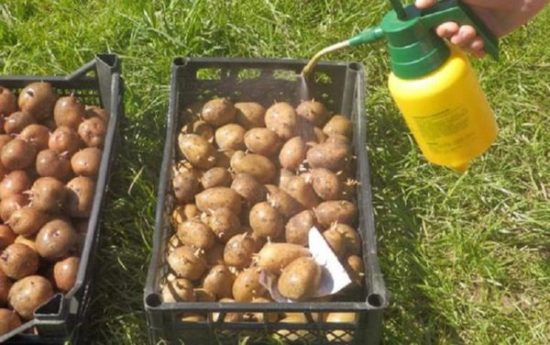

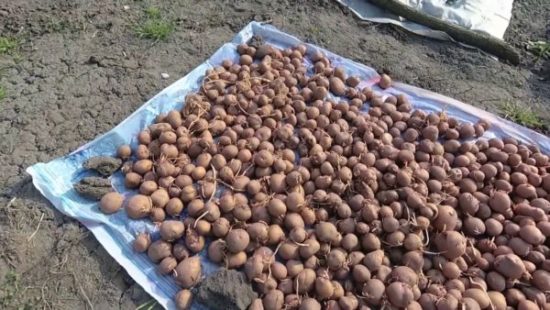
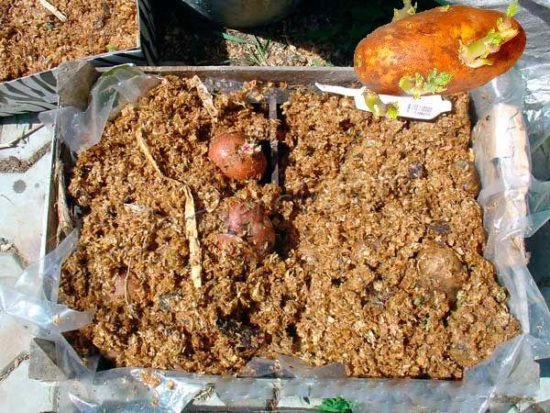
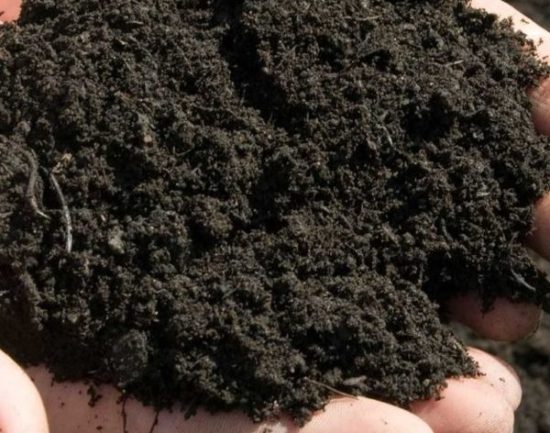
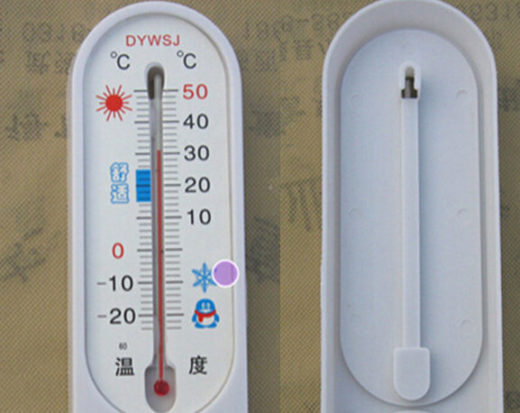
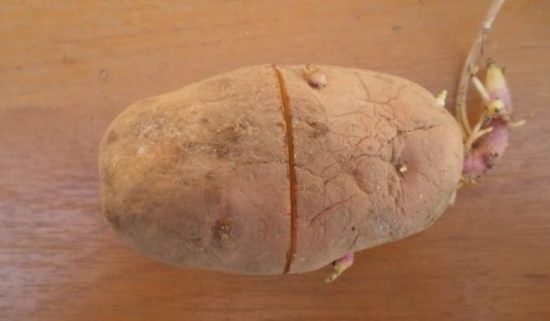
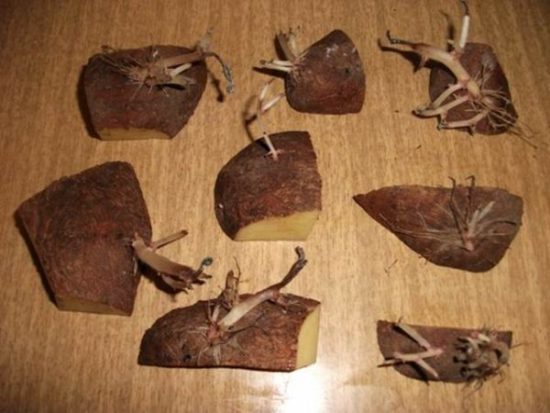

 (5 ratings, average: 4,40 out of 5)
(5 ratings, average: 4,40 out of 5) CUCUMBERS NEVER GET SICK, I'VE BEEN USING ONLY THIS FOR 40 YEARS! I SHARE A SECRET WITH YOU, CUCUMBERS ARE LIKE THE PICTURE!
CUCUMBERS NEVER GET SICK, I'VE BEEN USING ONLY THIS FOR 40 YEARS! I SHARE A SECRET WITH YOU, CUCUMBERS ARE LIKE THE PICTURE! You can dig a bucket of potatoes from each bush. Do you think these are fairy tales? Watch the video
You can dig a bucket of potatoes from each bush. Do you think these are fairy tales? Watch the video
 How our fellow gardeners work in Korea. There is a lot to learn and just fun to watch.
How our fellow gardeners work in Korea. There is a lot to learn and just fun to watch. Eye trainer. The author claims that with daily viewing, vision is restored. They don't charge money for views.
Eye trainer. The author claims that with daily viewing, vision is restored. They don't charge money for views. A 3-ingredient cake recipe in 30 minutes is better than Napoleon. Simple and very tasty.
A 3-ingredient cake recipe in 30 minutes is better than Napoleon. Simple and very tasty. Therapeutic exercises for cervical osteochondrosis. A complete set of exercises.
Therapeutic exercises for cervical osteochondrosis. A complete set of exercises. Which indoor plants match your zodiac sign?
Which indoor plants match your zodiac sign? What about them? Excursion to German dachas.
What about them? Excursion to German dachas.